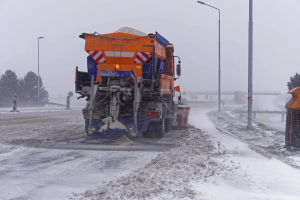by Andres Clavier, Freshwater Stewardship Education Intern
Recent research has highlighted concerning news: there has been a pronounced escalation in the salinization of our freshwater bodies over the past twenty years. If this trend continues, many Canadian lakes will reach critical levels in the next 40 years. Elevated salt concentrations can severely impair aquatic flora, lead to widespread fish deaths, and turn these freshwater zones inhabitable for many species. The implications extend beyond individual organisms; heightened salinity can reconfigure food webs and perturb natural cycles.
Our rivers, streams, and even crucial groundwater reserves are also seeing increases in salinity (Kaushal, et. al, 2005). Land wildlife are also suffering consequences; the pull of these salts lures them onto roads, pathways, parking lots, and roadsides. This elevates the risk of vehicular collisions and jeopardizes iconic Canadian species like moose, elk, and deer that are lured by the salt.
Increased salinity in freshwater systems due to salts can make water uninhabitable for certain species and disrupt aquatic ecosystems. Salts are decreasing the survival rate of wood frog embryos, and species such as brook trout and mussels are also notably being affected (Karraker, et. al, 2008; Gillis, 2011).
What is causing the increase in salinity?
As temperatures drop and icy conditions, salts become widely used by municipalities, businesses and private users to ensure safe passage on our highways and streets. Yet, beyond their safety benefits, there is an alarming cascading effect on our environment. Current trends of year-round high chloride concentrations are being observed with chronically high chloride concentrations overlapping with spawning periods and early-life stages for many species. While the use of salts occurs in the winter, the impacts are felt year-round.

How can we make a change?
To tackle this issue holistically, increased public awareness, improved designs to minimize runoff, enhanced monitoring, and revised regulations are critical. Today, reducing salt consumption is the only known solution to this issue. While other de-icing agents are available, their environmental repercussions have yet to be fully discovered, highlighting the necessity for more research. It is imperative to balance ensuring safety and preserving our delicate ecosystems, a challenge that demands our collective commitment and action.
A Call for Action
Watersheds Canada is initiating a salt pollution awareness campaign to advocate for more sustainable and eco-friendly de-icing practices. By supporting regulations, monitoring, and liability, we can safeguard our aquatic ecosystems, protect wildlife, and ensure the continued purity of our nation’s waters. You can be the ripple effect needed to spark change. Share this information with loved ones and peers, emphasizing the significance of joining hands against salt pollution. Stay tuned for more resources and blogs!
References
Corsi, S. R., Graczyk, D. J., Geis, S. W., Booth, N. L., & Richards, K. D. (2010). A fresh look at road salt: Aquatic toxicity and water-quality impacts on local, regional, and national scales. Environmental Science & Technology, 44(19), 7376-7382.
Gillis, P. L. (2011). Assessing the toxicity of sodium chloride to the glochidia of freshwater mussels: Implications for salinization of surface waters. Environmental Pollution, 159(6), 1702-1708.
Kaushal, S. S., Groffman, P. M., Likens, G. E., Belt, K. T., Stack, W. P., Kelly, V. R., … & Fisher, G. T. (2005). Increased salinization of fresh water in the northeastern United States. Proceedings of the National Academy of Sciences, 102(38), 13517-13520.
Karraker, N. E., Gibbs, J. P., & Vonesh, J. R. (2008). Impacts of road deicing salt on the demography of vernal pool-breeding amphibians. Ecological Applications, 18(3), 724-734.
This piece is part of an education toolkit generously funded by:



Could you forward this information to the Clean Annapolis River Project (CARP)
I went to a general meeting recently and brought this issue up but it seemed the implications of excessive road salting is not taken seriously. Any studies or references would be appreciated
carp@annapolisriver.ca